by the appropriate amount.
6-4
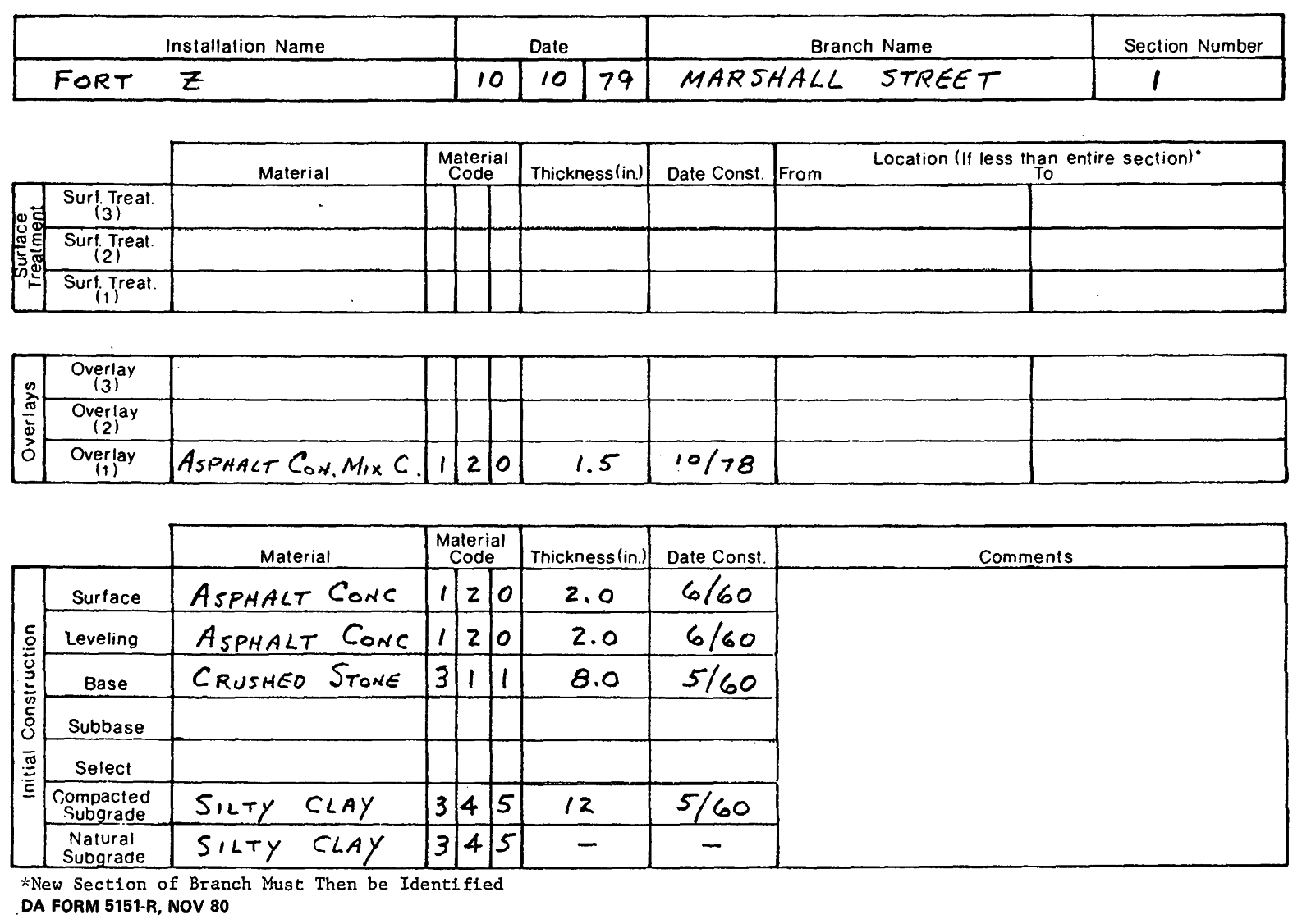
TM 5-623
SECTION PAVEMENT STRUCTURE RECORD
For use of this form, see TM 5-623; the proponent agency is USACE.
Figure 6-3. An example of a completed DA Form 5151-R, Section Pavement Structure Record.
6-5
TM 5-623
Table 6-1. Material Codes
Material Codes.
100 Surface Materials*
110
Portland Cement Concrete
155
slurry seal
111
plain
156
fog seal
112
reinforced concrete pavements (RCP)
157
asphalt rubber chip
113
continuously reinforced concrete
158
fabric
pavement (CRCP)
159
dust layering
114
prestressed
115
fibrous
160
Preformed Joint Fillers
161
bituminous fiber
120
Asphalt Concrete
162
cork
163
self-expanding cork
130
Road Mix Bituminous Surface
164
self-expanding rubber
140
Sand-Asphalt
165
sponge rubber
141
plant mix
166
closed cell plastic
142
road mix
170
Joint and Crack Sealers
150
Surface Treatments
171
hot-poured
151
single-layer aggregate seal
172
cold-poured
152
double-layer aggregate seal
153
three- or more layer aggregate seal
180
Others
154
sand seal
200 Treated or Stabilized Materials
210
Cement Treated
240
Asphalt-Treated Plant Mix
211
gravel and crushed stone
241
crushed stone
212
sand
242
gravel
213
silt and clay
243
sand
220
Lime-Flyash Treated
250
Asphalt-Treated Road Mix
221
gravel and crushed stone
251
crushed stone
222
sand
252
gravel
223
slag
253
sand
230
Lime-Treated Fine-Grained Soil
280
Others
300 Untreated Materials
310
Crushed Stone
333
high fines content
311
well-graded
312
poorly graded (one-sized)
340
Fine-Grained Soils
313
high fines content
341
sandy silt
342
silt
320
Gravel
343
clayey silt
321
well-graded
344
sandy clay
322
poorly graded
345
silty clay
323
high fines content
346
clay
347
organic silt
330
Sand
348
organic clay
331
well-graded
332
poorly graded
380
Others
*For unpaved roads, refer to treated or untreated materials list for identification purposes.
6-6
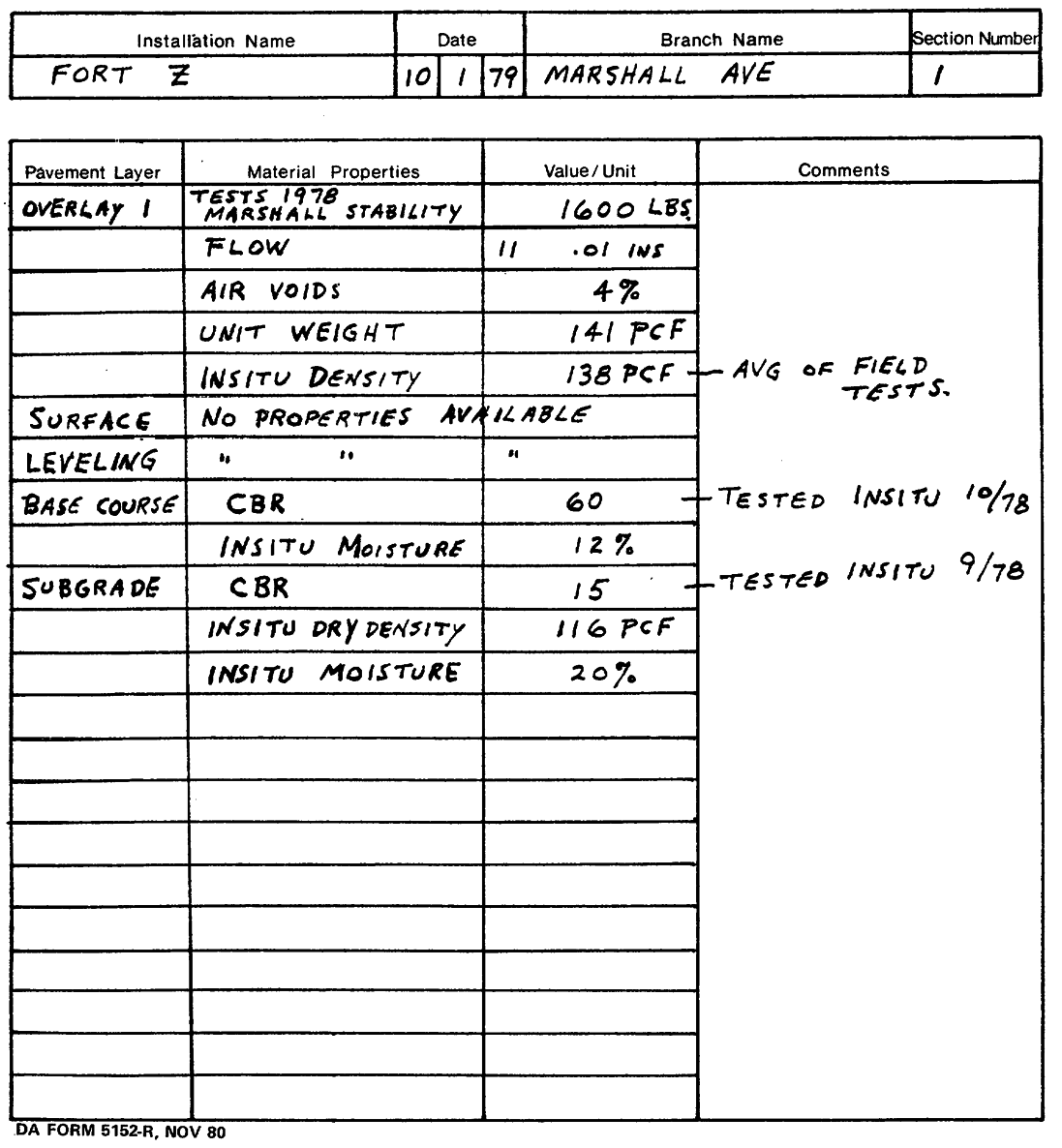
TM 5-623
SECTION MATERIALS PROPERTIES RECORD
For use of this form, see TM 5-623; the proponent agency is USACE.
Figure 6-4. An example of a completed DA Form 5152-R, Section Materials Properties Record.
6-7
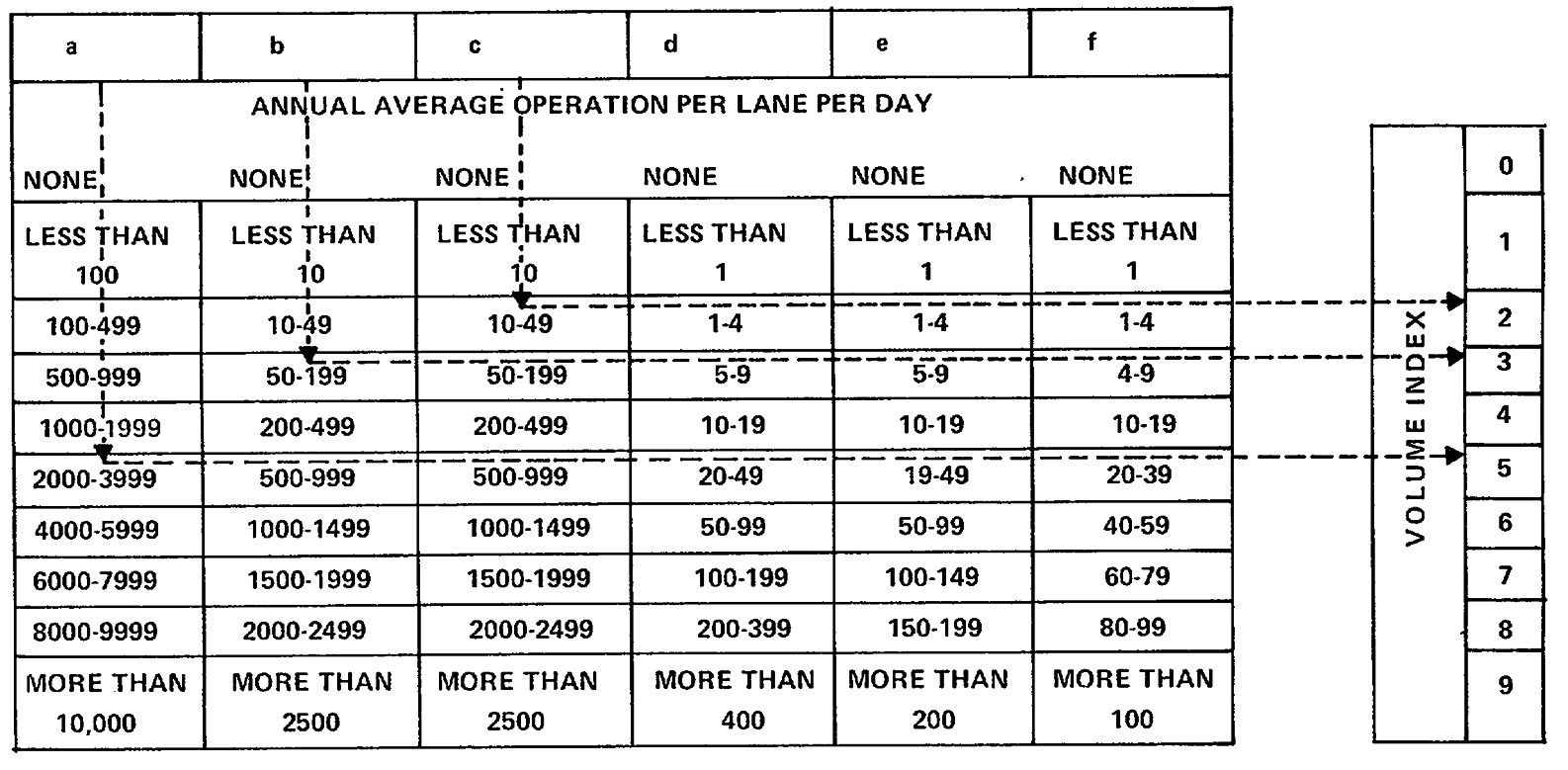

TM 5-623
Table 6-2. Typical Layer Materials Properties
1.
Asphalt Concrete (Surface, Leveling, Base):
4.
Subgrade:
Marshall stability (pounds)...Asphalt content (%)
Unified classification .................Liquid limit
Flow (0.01 inch) ..................Unit weight
CBR ..........................................Optimum moisture
(pounds/cubic foot)
control (%)
Air voids (5) ........................Asphalt penetration
K-value (pounds/square inch)....In-situ moisture content
(millimeters x 101)
(%)
Plasticity index ..........................In-situ dry density (% of
2.
Portland Cement Concrete (PCC):
optimum)
Modus of rupture (pounds/square inch)
Compressive strength (pounds/square inch)
(a) The volume of traffic for traffic type a was found
Entrained air (%).................
on the traffic survey of September 1978 to be 2500.
Water/cement ratio (gallon/sack).
Looking down column a, table 6-3, that value (2000-
3999) was located. Looking horizontally to the far right
3.
Base-Subbase Materials:
the column identified as "Volume Index" was reached at
k-value (pounds/square inch)
5. That value 5 was recorded on the form as the
CBR....................................
volume index for type a traffic for the survey date 9/78.
In-situ dry density (% of optimum).
(b) The volume of traffic for traffic type b was found
In-situ moisture content.......
on the traffic survey of September 1978 to be 85.
Looking down column b, table 6-3, that value (50-199)
was located. Looking horizontally to the far right the
Table 6-3. Traffic Volume Index for Roads
TRAFFIC TYPE
a
Passenger, panel and pickups.
b
Two-axle trucks and buses; also half-or full-track vehicles less than 20 kip, and fork lift trucks less than 5 kip.
c
Trucks with three or more axles. Also half- or full-track vehicles 20-40 kip, and forklift trucks 5-10 kip.
d
60-kip track vehicles and/or 15 kip forklifts. Number of operations per lane per day for tracked vehicles 40-60 kip and/or forklift trucks 10-15 kip.
e
90 kip track vehicles and/or 20 kip forklifts.
f
120 kip track vehicles and/or 35 kip forklifts.
6-8
TM 5-623
"Volume Index" was reached at 3. That value 3 was
section is inspected by sampling, the number of random
recorded on the form for type b traffic.
and additional units surveyed is recorded. If all sample
(c) The volume of traffic for traffic type
units are surveyed, the number is recorded as random
c was found on the traffic survey to be 15. Looking
units.
down column c, table 6-3, that value (10-49) was
(g) The PCI range is computed, by
located. Looking horizontally to the far right the
subtracting the lowest sample unit PCI from the highest
"Volume Index" was reached at 2. That value 2 was
sample unit PCI, and recorded (in the example, 20).
recorded on the form for type c traffic.
(h) The minimum number of sample
(d) The volume of traffic for traffic
units to be surveyed is determined and recorded (in the
types d, e, and f was zero. The "Volume Index" was example, 5). Determination of minimum number of
therefore zero and that value was recorded on the form
sample units to be surveyed is described in chapter 3. If
for traffic types d, e, and f.
the minimum number of sample units required is greater
(e) The volume indices for the traffic
than the number of random units surveyed, more units
survey of August 1979 was determined as indicated
must be selected at random and surveyed.
above for the 1978 survey. The values determined
(I) The pavement type is determined
( a=6, b=4, c=1, d=0, e=0, f=0) were recorded on the and recorded. (In the example, AC is marked to
form for the survey dated 8/79.
indicate asphalt-surfaced pavement. If the pavement
(2)
Space is provided at the bottom of Form
had been concrete, PCC would have been marked.)
5153-R marked "Parking Lots-Airfields-Other." This
(j) The section dimensions and area
space should be used for describing the type and
are marked (in the example, 25 feet by 500 feet, 1388
volume of traffic using facilities other than roads. For
square yards).
example, if the pavement section being considered is a
(k) The method of determining the
parking lot, the description of traffic can be, "The
section distress data is marked. (In the example,
dominant type of vehicle using the parking lot is
"Actual Quantities" is marked because the entire section
passenger cars, averaging 12 hours per day." This
was inspected. If inspection by sampling was used the
information is used when evaluating the existing
circle next to extrapolated quantities should be marked.
pavement section or when designing a new cross-
(l) Once it has been determined that a
section.
sufficient number of sample units have been surveyed,
the section distress data portion of the form can be
g. DA Form 5154-R, Section Condition Record.
completed. If actual quantities are used (i.e., the entire
The Section Condition Record stores data obtained from
section inspected), the section's values are found by
the condition survey of the section's sample units and
totaling the quantity of each distress type and severity
summarizes the distress found in the section.
level. The section density and deduct values are then
(1)
A completed DA Form 5154-R is shown
computed as normally done for a sample unit (See para
as an example in figure 6-6. The form is completed as
3-5d(1) for asphalt pavements and para 3-5d(2) for
follows:
concrete pavements). (In the example the distress
(a) The installation name, the branch
portion of the form has been completed starting with
name, the date and the section number is recorded at
Distress Type 1, Severity Level L, Quantity 30, Section
the top of the form.
Density .24 and Deduct Value 4.)
(b) The average PCI of the sample
(m) The deduct values are totaled (in
units (in the example, 70) is recorded as well as the
the example, 47).
condition rating (good).
(n) On the last line of the form the
(c) Ratings for ride quality, safety, and
percent deducts related to structural, environmental, or
drainage are recorded by marking the appropriate space
other conditions is marked (in the example, 75 percent
(G for good, F for fair, P for poor). In the example the
structural, 25 percent other).
ratings are good. The ratings on the form are for
general information since the PCI accounts for each of
(2)
The completed Section Condition Record
these factors through distress types.
with distress information can be used to evaluate M&R
(d) The total number of sample units in
requirements and to provide quantities of repair for cost
the section is recorded (in the example, 5).
estimates. It is very important to note that the deduct
(e) The number of random units
surveyed is recorded. In the example, five units (all the
units) were surveyed.
(f) The number of additional units
surveyed is recorded (in the example, zero). If the
6-9
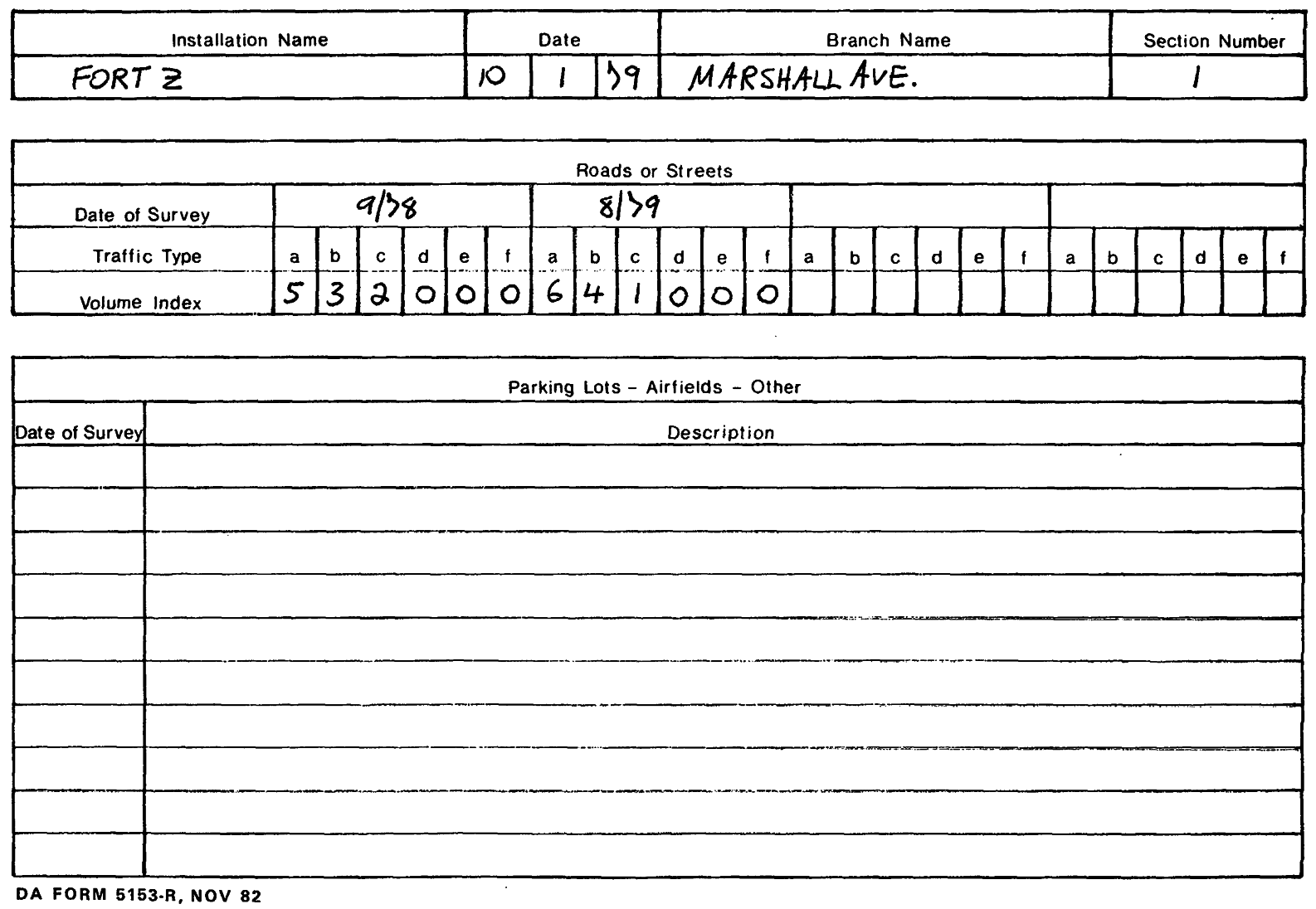
TM 5-623
SECTION TRAFFIC RECORD
For use of this form, see TM 5-623; the proponent agency is USACE.
Figure 6-5. An example of a completed DA Form 5153-R, Section Traffic Record.
6-10
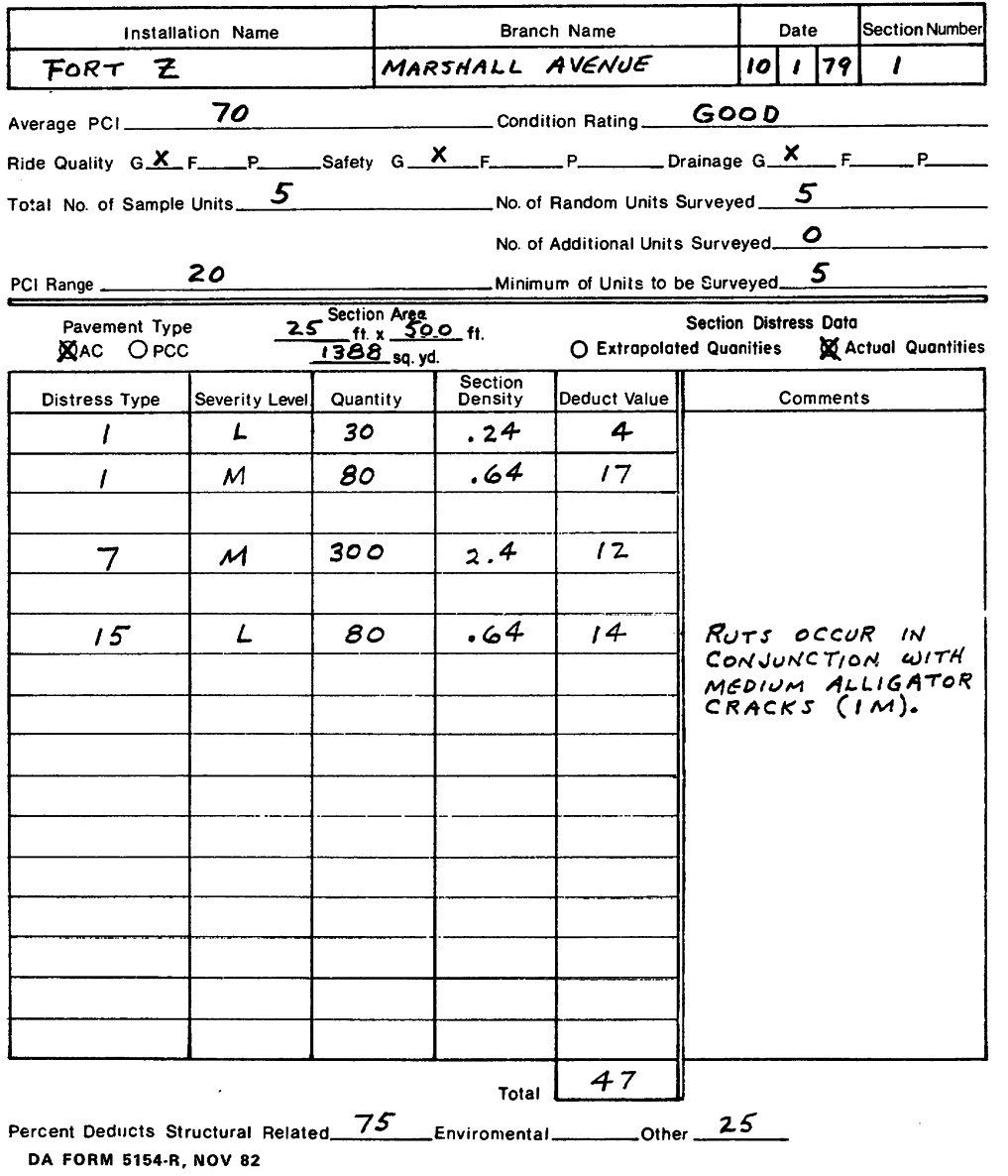
TM 5-623
values determined from these data cannot be used to
(3)
The percent of deducts relating to
complete the PCI of the section.
structural, environmental, or other conditions are used
when performing the section evaluation described in
chapter 4.
SECTION CONDITION RECORD
For use of this form, see TM 5-623, the proponent agency is USACE.
Figure 6-6. An example of a completed DA Form 5154-R, Section Condition Record.
6-11
TM 5-623
h. DA Form 5155-R, Branch Maintenance and
similar to that kept on DA Form 5155-R, except that the
Repair Requirements. This form stores information on
completion date of M&R is listed for each activity and
required M&R activities; it is completed by using
the cost should be the actual cost of M&R rather than an
information previously recorded on DA Forms 5150-R
estimate. A completed DA Form 5156-R is shown as an
through 5154-R. A form should be completed for each
example in figure 6-8. The form was completed similar
branch of the pavement network. For a detailed
to DA Form 5155-R. The actual rather than the
explanation of how to determine M&R requirements, see
proposed thickness, quantity and cost were recorded.
chapter 4.
(1)
A completed DA Form 5155-R is shown
6-4. Manual record keeping system-general
as an example in figure 6-7. The form was completed
The manual record keeping system consists primarily of
as follows:
the nine forms described in paragraph 6-3. Those forms
(a) The installation name, date, branch
are used for information storage. To use data
name and total number of sections in the branch was
efficiently, this information must be stored in an orderly
recorded at the top of the form. (In the example there
fashion. Figure 6-9 is an example of such a system; it
are 6 sections in the branch.)
can be described as follows:
(b) All branch maintenance and repair
a. Branch summary. One folder stores the network
work required was listed. The section number where the
inventory. This is the information recorded on DA Form
work was needed was recorded. The work item was
5149-R, Branch Identification Summary.
described. The work class was recorded ( M for
b. Branch identification information. One folder
maintenance, rather than R for repair, or C for new
stores branch identification information. This folder
construction). The location of the proposed work ( R for
serves as a heading card and as the storage slot for DA
roadway, rather than PL for parking lot, A for airfield, or
Form 5155-R, M&R Requirements. (This allows
O for other) was recorded. The thickness of the
anticipated maintenance activities for each section of
proposed work was recorded. The quantity of the work
the branch to be stored in one location.) The branch
item was recorded. The estimated cost of the work item
identification forms should be filed in the order shown on
was recorded. The priority that the work item rated was
the DA Forms 5149-R, Branch Identification Summary.
recorded. A final column provides space for recording
c. Branch sections. After the Branch Identification
the date the work item is completed.
Summary forms, a series of file folders should be
(c) The lower area of the form is for
provided for each section of the branch. One folder
remarks. An appropriate comment was recorded.
each is provided for DA Forms 5149-1-R, 5150-R, 5151-
(2)
The information on the Branch M&R
R, 5152-R, 5153-R, and 5154-R. (These forms contain
Requirements form may change frequently. For
basic information on the section.)
example, when a work item is completed, other priorities
d. Inspection forms. Field survey data on the
may change. So the date of completion of the work
sample unit inspection sheets should be retained. This
item must be recorded and priorities updated at that
information is included on the DA Form 5154-R, Section
time.
Condition Record (fig 6-6); however, the inspection
(3)
Since the information on the Branch M&R
sheets can help verify data, and would be essential if
Requirements form(s) changes frequently, a new form
the installation wanted to convert from the manual
should be made when necessary. Information on
PAVER system to a computerized PAVER system.
completed M&R activities should always be transferred
to a DA Form 5156-R, Section Maintenance and Repair
6-5. Record upkeep
Record, as a permanent record.
Once the initial division of the pavement network into
branches and sections has been completed, the filing
I. DA Form 5156-R, Section Maintenance and
system can be started. As the initial inspections take
Repair Record. This form stores information on
place, the information on DA Forms 5149-1-R through
maintenance and repairs that have been completed. It
5153-R can be compiled. As branches are completed,
can be compiled from data from DA Form 5155-R and
data analyses can begin (chap 4).
as-built records. A separate form is used for each
a. Updating forms. Forms must be updated once
section; this allows the expenditures for maintenance of
maintenance activities begin. If overlays or surface
each section to be monitored. This type of information
treatments are applied, the DA Form 5151-R, Section
may be valuable when determining M&R requirements
or when performing economic analyses on other
sections. The information on DA Form 5156-R is very
6-12
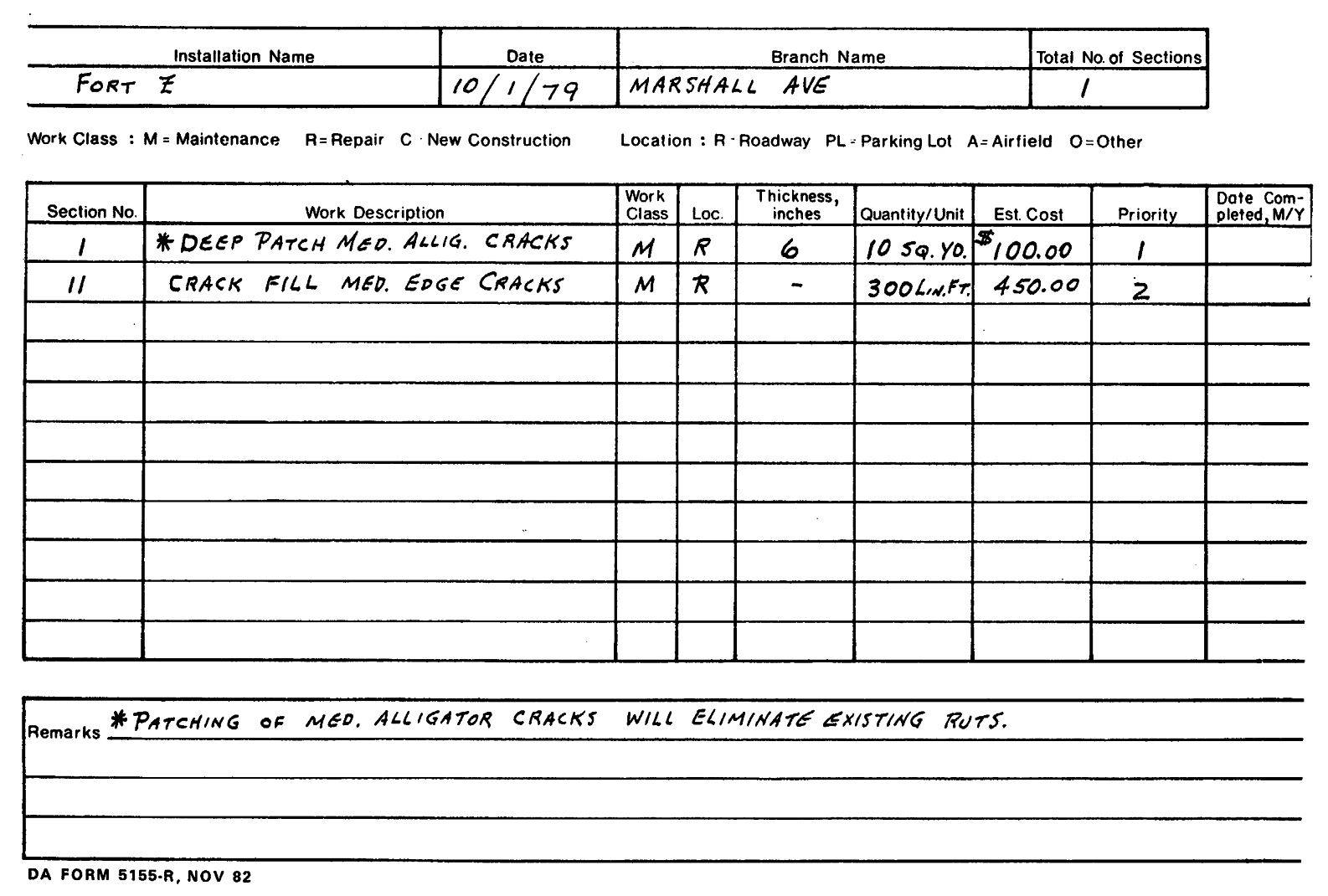
TM 5-623
BRANCH MAINTENANCE & REPAIR REQUIREMENTS
For use of this form, see TM 5-623; the proponent agency is USACE.
PAGE 1 OF 1
Figure 6-7. An example of a completed DA Form 5155-R, Branch Maintenance and Repair Requirements.
6-13
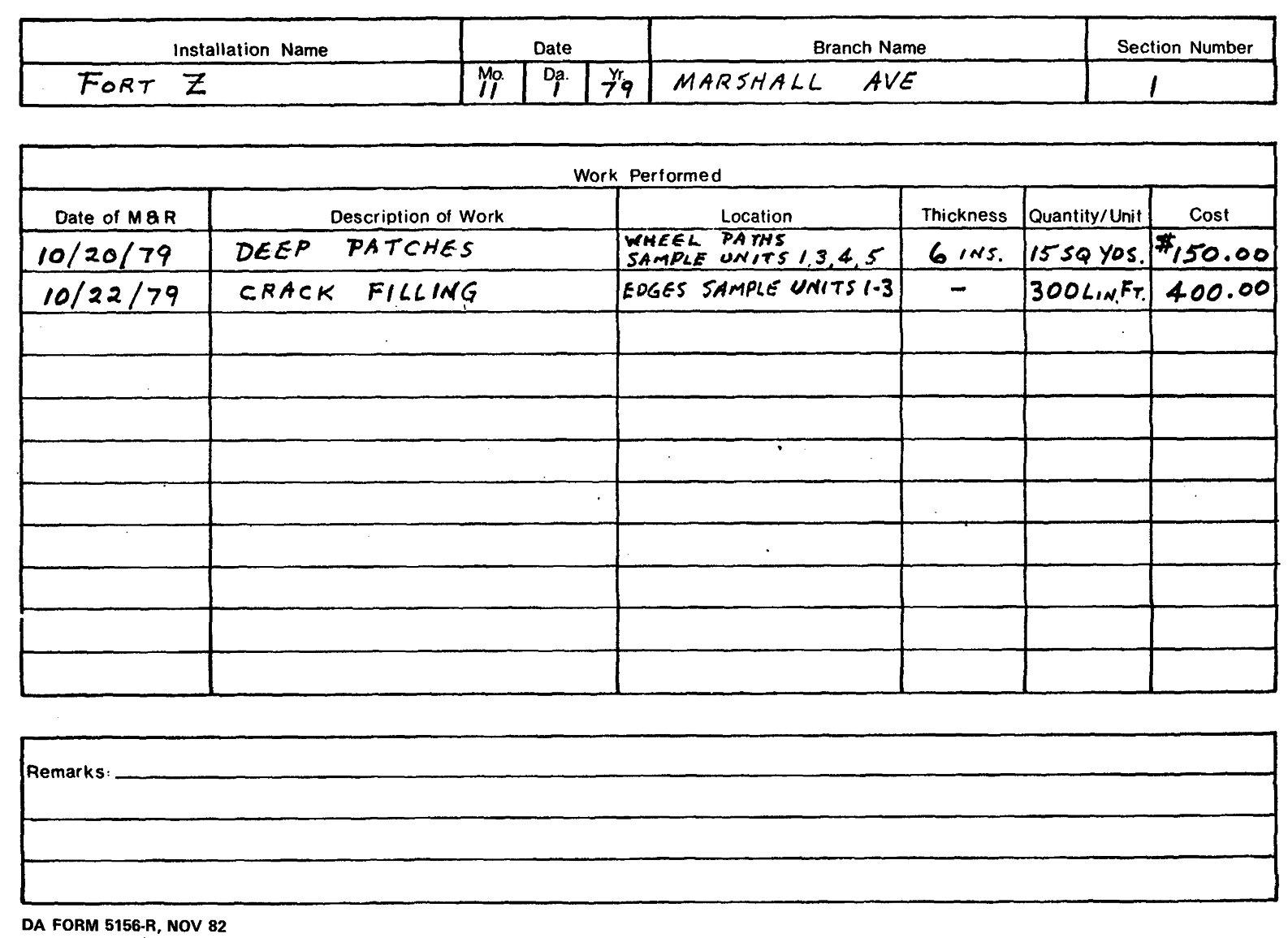
TM 5-623
SECTION MAINTENANCE AND REPAIR RECORD
PAGE 1 of 1
For use of this form, see TM 5-623; the proponent agency is USACE.
Figure 6-8. An example of a completed DA Form 5156-R, Section Maintenance & Repair Record.
6-14
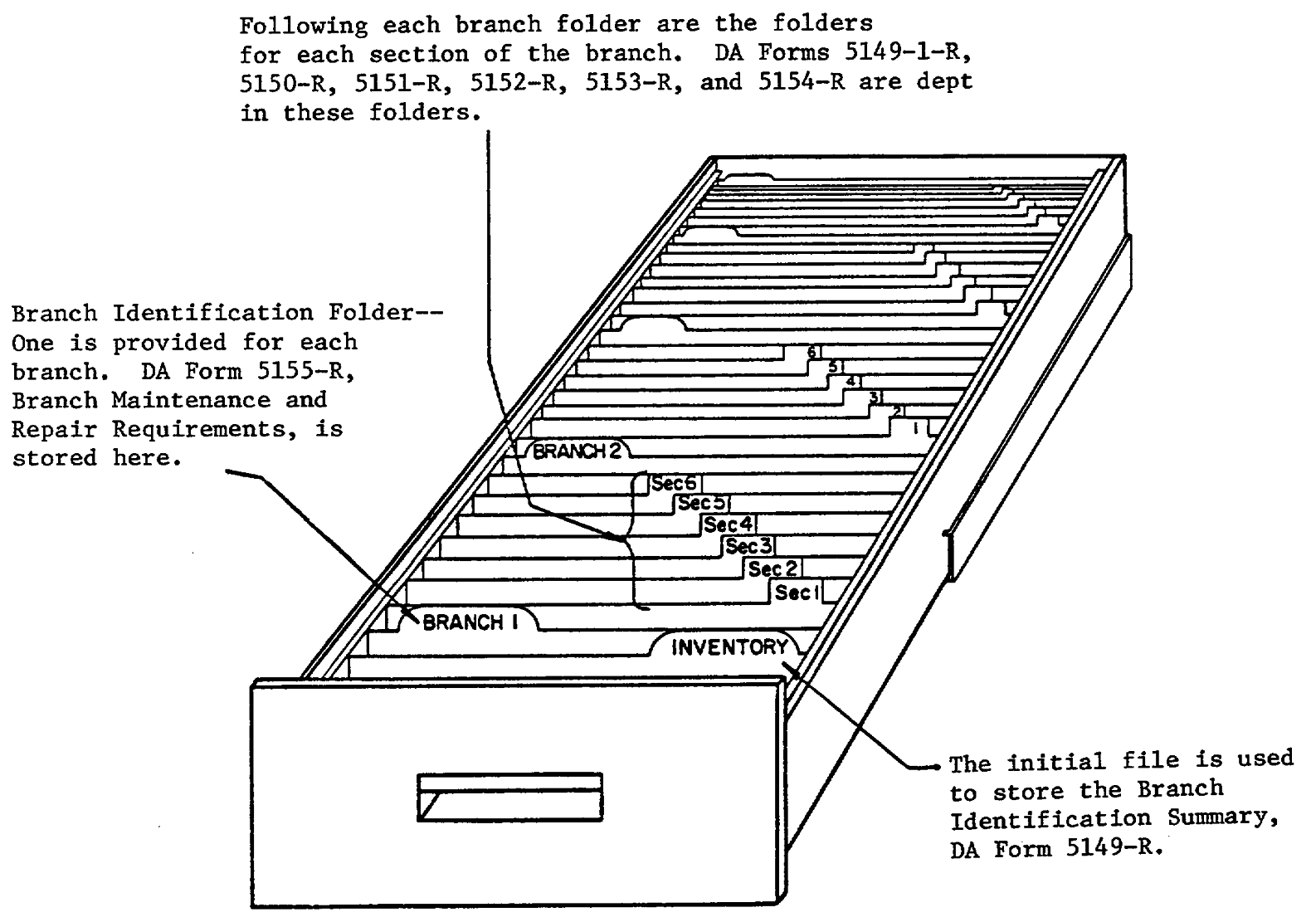
TM 5-623
Pavement Structure Record Card, must be updated.
severity’s. Until data are compiled, sections should be
Also, as work is completed, information from the DA
reviewed at least annually to observe this change in
Form 5155-R, Branch M&R Requirements, must be
condition. Once the rate of deterioration is determined,
transferred to the DA Form 5156R, Section M&R
sections with low rates may be inspected at more
Record. Performance of maintenance activities will also
infrequent intervals. If the filing system is updated
change the condition of the section; thus, the condition
continuously as work is performed and inspections are
survey should also be updated.
completed, it should not be necessary for the pavement
engineer to perform a condition survey of the entire
b. Updating of condition survey. If a section
system all at one time.
receives no maintenance, the condition survey should
c. Economic analysis. Any economic analysis
be updated based on the rate of deterioration. Initially,
performed to determine M&R strategies for given
this rate can be estimated by briefly inspecting the
sections should also be filed with the section information
section to observe changes in distress types or
cards.
Figure 6-9. Example of a filing sequence for a manual record keeping system.
6-15
TM 5-623
CHAPTER 7
DATA MANAGEMENT-COMPUTERIZED PAVER SYSTEM
7-1. Purpose
each automated system report, including content and
a. Computerized data management. The manual
use, is contained in appendix D.
data management sy












